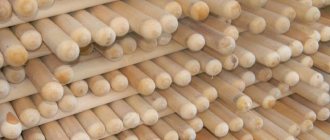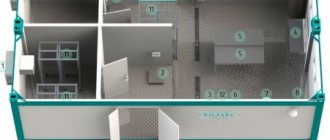If you are facing any construction, the first thing you will need on site is a construction shed. Of course, such a structure can be purchased ready-made, but the price will not be small. It is much easier and more economical to do it yourself. So that you don’t have to rack your brains looking for blueprints of the cabin, counting materials and drawing up estimates, you can use the proposed version of the cabin. A step-by-step guide with drawings and photos will help you at the assembly stage.
Understanding the types of cabins
The most popular among their variety are two types of trailers:
- Construction _ The main requirements for them are strength, reliability, ability to withstand frequent “moving,” and compliance with GOST. Metal is most often used as the frame of these cabins, and less often a combination of metal and wooden elements is used. They can have winter and summer versions.
- Country houses . As a rule, these cabins are made on the basis of a wooden frame made of timber using wood materials. For aesthetic purposes, they are often supplemented with decorative elements. Also, cabins of this type can be converted into a bathhouse, and with additional insulation they can be used for winter living.
The variety of designs of cabins is achieved mainly due to the variability of the layout. Thus, trailers can include one or two rooms, have a flat roof or with a slope, be equipped with various types of beds (usually bunk beds), elements for installing heating devices, etc.
As for the sizes and basic design features of cabins, products for summer cottages and other areas of “domestic” use can be made to order with a “reasonable” range of parameters. When it comes to construction sheds and modular containers, the manufacturer must follow the requirements of GOST 22853-86 “Mobile buildings (inventory). General technical conditions".
According to this document, frame cabins can be towed (with removable and non-removable chassis) and transportable. It also clearly stipulates the permissible dimensions of the cabins, climatic options (northern, conventional, southern), requirements for equipment, fire safety and others. Compliance with regulations is a prerequisite for cooperation with most customers of cabins, whether they are representatives of the public sector or private structures.
What types of cabins are there?
Change houses are used for temporary housing of people.
Main types of trailers:
- country (garden);
- construction;
- combined.
Country trailers are most often made from wood (timber, chipboard). They are ergonomic and quite durable. Suitable for accommodating people in the warm season (for cold times, additional insulation is required). They are distinguished by their decorative properties - the body of the block container can be decorated with special inserts and other original details. Also used as sheds and workshops.
The cabins can be disassembled or transported assembled.
Construction trailers are made of metal - a frame made of channels, which are secured by welding. Such structures are distinguished by strength, endurance, and are popular among workers and builders.
Combined block containers are made of metal and lined with wood.
We decide on the format of work and assortment
The most budget-friendly option for organizing a business for the production of construction and summer cottages is a small enterprise (usually) engaged in the manufacture of custom-made products with certain parameters. The productivity of such a company can reach 10-12 cabins per month. Large customers require large volumes, so in this case you should focus on the population or small companies.
The main advantages of this operating algorithm are small start-up capital, minimal investment in equipment and production premises, and the absence of the need for warehouses for raw materials and areas for storing finished cabins.
If you have the funds and the desire to build a large-scale business, you should focus on the production of block containers and cabins, both of a standard design (for which you should develop several versions of products for different purposes and be ready to leave a certain number of them at any time), and custom-made trailers with parameters specified by a specific customer.
Organizing stream production will require significant financial investments. Moreover, most of them will be used to purchase equipment, organize a workshop and produce the first batch of standard cabins. The specifics of the business are such that when working to order, the manufacturer takes an advance payment of up to 70% for each cabin. Accordingly, in most cases, the purchase of materials is carried out at the customer’s expense. However, this only works if the company manages to acquire a good reputation. Accordingly, from the very beginning you should carefully consider the advertising campaign of the production and maintain the quality of the products at a high level.
Organization of production of cabins
The usual width of household trailers is 2.5 m, the length is over 3.5 m, and the height is approximately 2.3 m. However, the model range and standard sizes may differ. The dimensions of the structure increase by 1 meter with each step of the model range. The assembly of such structures requires large production areas. The main stages of assembly can be carried out in an open space under canopies.
Preparation for the assembly of individual structures of household trailers must be carried out in enclosed spaces, protected from precipitation and wind. The minimum production area for assembling structures is 50 m2. When switching to a flow production system, the minimum area of production premises should be 500 m2.
The range of production of household trailers can be significantly increased by increasing the number and variety of planning options, which can consist of several rooms. Medium and large manufacturers produce standard versions of cabins of standard designs.
Small enterprises that do not have large warehouse facilities are forced to work on individual orders or produce simple types of household trailers.
Both options have their own advantages. Custom work is characterized by lower construction costs and higher productivity. However, to organize continuous production, significant capital investments are required. Firms with a good business reputation, in the case of work “to order”, can take a high advance payment from the customer company, which can be about 70% of the order price. This circumstance allows you not to spend your own funds to rent production space and purchase the necessary materials.
In the second case, production profitability will be lower. The number of orders may be limited by the production area of the workshops and the number of working personnel. The most significant disadvantage of this form of work is the reputation factor: in order to obtain consent from the customer for a large advance payment, the contractor must have an impeccable business reputation. In this case, the main way to find and attract clientele is word of mouth.
Regardless of the size of the mini-factory for the production of household trailers, its staff must necessarily include engineers and sales managers. Engineers ensure the development of drawings of manufactured structures and ensure compliance of finished products with customer requirements, as well as technical specifications and government standards. Managers are responsible for the marketing of manufactured products. Household trailers are a specific product. They have the advantages of a relatively low price and a wide range of applications, but finding buyers for them is a rather difficult task. Competition in this market segment is quite high. The advantage is that the overwhelming number of competitors are small producers with relatively low quality products.
To achieve success in this market, it is not enough to monitor the quality of products. Additional service conditions must be provided for clients. For example, household trailers are considered bulky and inconvenient for transportation, which is quite difficult to deliver to operational facilities, which is often associated with big problems for buyers - individuals. Organizations may have their own trucks and truck cranes. If you take on all the problems associated with transporting cabins to customer sites, you can be sure that you will receive excellent recommendations and new clients.
It is also necessary to ensure the installation and installation of the supplied household trailers on site: this can be done for an additional fee.
This commercial solution provides two advantages at once: the degree of customer loyalty increases and the risk of damage to the cabins during installation and installation is reduced.
Organizing the delivery and installation of products does not require large capital investments: it is not necessary to have your own trucks and truck crane; you can rent them from a reliable transport company.
Technology for the production of cabins + Video of how they make them
Individual operations for the production of wooden frames, construction cabins and block containers may differ, but in general the algorithm is as follows:
- Making the frame . In the case of wooden structures, high-strength wooden beams are used, for construction trailers - metal profiles. It is important to take into account the parameters of the maximum load, since cabins are often installed on top of each other. In addition, for many customers, the number of assemblies/disassemblies for which the structure is designed is of decisive importance. For example, if we are talking about a construction company, the client will want the ordered cabins to be transported from site to site without loss of strength. Accordingly, the fastening system should be as flexible as possible and not require special skills from employees who will later be involved in assembly and dismantling.
- External cladding . Corrugated sheets, wooden lining, sandwich panels and other materials can be used as walls in cabins. The most important requirement is resistance to corrosion, mold and bending, as well as compliance with fire regulations.
- Roof installation . Most often it takes the form of a flat surface made of galvanized metal, since this allows the trailers to be installed one on top of the other. In the case of country cabins, the roof can be pitched from wood or metal - at the request of the customer.
- Internal lining and insulation . To furnish the walls, lining made of wood and plastic, plasterboard, hardboard, MDF, etc. can be used. The most common insulation materials are mineral wool and synthetic materials. In winter versions of cabins, not only the walls are insulated, but also the floor, ceiling, and door leaf.
- Laying the floor . The floor surface is covered with chipboard with a thickness of at least 16 mm or a floorboard with a thickness of 28 mm. As an additional option, linoleum can be laid on top.
- Laying communications . Power supply networks, equipment for connecting water supply, ventilation, heating are also additional options and are equipped at the customer’s request.
- Installation of windows and doors . As a rule, these cabin modules have standard sizes. In some cases, it makes sense to offer the customer the installation of additional grilles and shutters.
Regardless of the type of cabins, the assembly process itself, the materials and quality of the final product must comply with regulatory documentation, the requirements of the SES and fire protection authorities.
Assembling the base of the cabin
So, you have a plot . First of all, decide on the location of the shed and you can get to work. We install the cabin in the following order:
- We begin construction from the platform, or rather from the insulated floor, from which we will continue to dance.
- Using pegs and rope, we mark the area and install cement-sand blocks with equal spacing along the perimeter of the proposed cabin.
- Then, from a 6-meter edged board with a cross-section of 150x50 mm, we make a harness, laying it on blocks.
- We attach logs to the harness with a pitch of 1221-1222 mm. We trim the lower edge of the joists with a 50X50 mm block and attach the subfloor beams to them from below. Tip: for the subfloor, you can take uneven bars, and to save material, a 50X50 bar can be sawn in half lengthwise.
- Then we lay insulation boards in the gaps between the joists on the subfloor boards.
READ MORE: 1
Let's start organizing production
First you need to find a site for organizing production. The minimum length of a standard cabin is 3 m, width is 2.3 m. With the expansion of the model range, these dimensions increase by 1 m each time. Accordingly, even to assemble one cabin a certain area will be required. If you plan to work on several structures simultaneously, the size of the site should be quite impressive.
It should be taken into account that the assembly of the change house itself can be carried out on an open area covered with crushed stone to protect it from dirt if there is a canopy that will protect the structure from precipitation. To prepare structural elements, store materials and tools, you will need a closed room with an area of at least 50 m². A full-fledged indoor workshop for large-scale production of change houses can occupy about 500 m².
It is necessary to arrange a comfortable entrance on the site for equipment with a low-loading platform, with the help of which the cabins will be delivered to customers. It would be a good idea to ensure that you have an exhibition sample of your product. And this is also additional space.
The minimum equipment that will be required at the initial stage of doing business includes:
- welding machine;
- 3-4 grinders;
- perforator;
- hand circular saw;
- screwdriver;
- electric jigsaw;
- electric plane;
- other hand tool.
When a sufficient number of customers appear, you can think about purchasing stationary devices.
Of course, the necessary conditions for the functioning of production are the availability of electrical communications and water supply. Indoor areas may require heating. It would be a good idea to provide security who will make sure that everything necessary for making the cabins does not disappear from the territory on the very first night.
Manufacturing process
The entrepreneur views the production of cabins as a highly profitable business. Therefore, it takes into account the classification of inventory buildings according to the following criteria:
- purpose – gardening, construction, summer cottage, bathhouse, technological, administrative, commercial;
- material design - metal, sandwich panels, wood, timber, SIP;
- design – collapsible, container;
- layout - “vest”, “divided room”, with a vestibule, with partitions, with a terrace/veranda, with a porch, with a toilet, with a kitchen, with a shower;
- chassis - wheeled, sled, frame, without chassis.
With the help of cabins, the idea of a modular building can be realized if they act as its assembly units. The classic technology for making a cabin looks like this:
- installation of a power spatial frame made of timber, metal profiles, boards;
- exterior wall cladding with clapboard, siding, corrugated sheets, corrugated metal;
- construction of partitions, vestibules;
- installation of window and door blocks;
- vapor barrier, insulation, sound insulation of enclosing structures;
- interior finishing, wiring of engineering systems;
- finishing interior decoration.
Accordingly, parts of the supporting frame and enclosing structures are required for assembly. They are made from structural materials at the procurement site. The use of sandwich panels allows increasing labor productivity and manufacturability of production.
Search for production areas
As standard, construction cabins are large-sized products - length 3 - 12 m, width 2.3 m, height 2.4 m. Carriages with an all-metal frame without their own chassis are transported on trailers, trawls, semi-trailers. Collapsible cabins are folded for transportation into packages, several of which can fit in one truck.
Inventory buildings with non-standard dimensions are produced to order. To transport these cabins, a special permit is issued from the traffic police, a route is drawn up, and a police escort is provided.
To assemble container structures, a workshop with a minimum size of 5x15 m is required. The height of the room should allow the installation of a crane for assembly and loading of finished products. Depending on the planned production volume, the number of engineers, assemblers, and management personnel is calculated. The main requirements for the premises are:
- availability of access roads and turning areas for trucks with trailers;
- proximity to transport interchanges, lack of dense buildings.
The office can be located in an industrial zone or within the boundaries of a populated area. Without a physical address, it is impossible to register a company.
Purchase of materials
The most vulnerable point of the business plan is the region's raw material base. It may not have lumber or its cost will be significantly higher than in neighboring areas. Supply volumes must take into account the number of monthly products produced, the transportation time of boards, metals, timber, components, and additional elements.
To store structural materials, a room with a fire, security alarm, and access control is required. The cost of a metal cabin is much higher than that of a wooden trailer, and the design of the supporting frame is easier to manufacture.
Equipment purchase
The quality of assembly of a change house on a conveyor belt is much higher than handicraft production “on the knee”. To make a wooden country house you will need a set of networked power tools:
- drill;
- manual frezer;
- Circular Saw;
- screwdriver;
- grinders.
But after assembly, it is physically impossible to lift the construction trailer manually. You will need a hoist, a crane, and a lift, first for storing the cabins, then for loading them onto a trailer during shipment to the customer.
Recruitment
For each structural material in the production of inventory buildings, its own technology is used:
- production of construction cabins - welding of metal frames;
- production of wooden cabins for SNT sites - frame technology platform or half-timbered;
- production of cabins from timber - log house technology or type-setting wall;
- prefabricated change house - fitting the steel elements of the load-bearing frame to bolted connections.
Accordingly, the list of professions is not the same for the specified methods of assembling inventory buildings. The designer's qualifications usually allow him to develop projects for cabins made of any materials.
Production technology
Since metal change houses must comply with the GOST standard, the manufacturer must develop MK and KTP maps and comply with them when manufacturing products. For inventory buildings, two modifications of frame technology are used:
- container type - half-timbered frame with a rigid self-supporting frame made of metal or lumber;
- prefabricated type - Platform for element-by-element assembly on site.
The cabins must be 100% ready for use. Therefore, interior finishing, decoration of facades, and installation of engineering systems, if any, are carried out at the factory. Therefore, in addition to carpenters, welders, fitters, the staff includes finishers, plumbers, roofers and craftsmen of other professions.
During the preparation of route and technological maps, the equipment, complexity of the project, and materials used are taken into account.
Sales
At the initial stage, the production of trailers does not exceed 8 pieces per month. A wooden change house for a SNT plot measuring 2.3x6 m costs from 65,000 rubles and is in seasonal demand. Without creative advertising, problems will definitely arise with the sale of inventory buildings.
The manufacturer will not be able to reduce prices, is not a monopolist in the region, and does not have a reputation in its niche. Investments in marketing in this case are economically justified. It is better to spend a relatively small amount on market research than to go bankrupt without being able to sell finished products.
Calculating the size of investments
The amount of start-up capital will largely depend on the region of business. It is logical that it is more expensive to open a production facility in the Moscow region than in Kaluga.
When making calculations, the following factors should be taken into account:
- Rent for 3 months. You may need time to “test” production points and produce the first batch of products.
- The cost of materials (metal, insulation, sheathing, paintwork, etc.) for the manufacture of 2-4 cabins.
- Purchase of equipment and hand tools.
- Payment of electricity bills.
- Employee salaries.
- Advertising costs.
- Payment of the fee for company registration. Opening a bank account, making a seal, etc.
Also, the purchase, leasing or rental of a truck crane should be recorded in the expense section.
We solve organizational issues
If initially or in the future a new enterprise plans to cooperate with legal entities, LLC should be chosen as the organizational and legal form of the company. The fact is that large customers often refuse to work with individuals due to the impossibility in this case of writing off the costs of cabins as expenses. There are also nuances with VAT and non-cash payments. Accordingly, an entrepreneur needs to open a current account and contact the tax authorities to prepare the necessary documents.
How much can you earn making cabins?
By selling a change house worth 70 thousand or more, you can make a profit of up to 25 thousand rubles. At the same time, finding new clients can be quite difficult. Also, a small organization is always limited by the amount of work it can do. Construction companies can purchase up to 15 cabins. In this case, you can get a net income of up to 350 thousand rubles. A team of three workers is capable of producing 7-8 trailers per month. If you have constant orders and increase production workload, you can have quite high profits. In addition, it is worth considering the option of renting out cabins. This can bring you good extra income.
How to build a utility block with your own hands from different materials (read more)
We are hiring staff
To manufacture one cabin, you will need 3 people with experience in installation work and metal cutting. In this case, it is necessary to have an employee familiar with the functionality of the welding machine. In this composition, one cabin will take from 3 to 5 days.
Regardless of the size of the company, there must be a process engineer on staff who will take measurements, make changes to standard designs of cabins, according to customer requirements, monitor the work process and compliance of the quality of the finished product with the requirements of the standards.
You will also need to hire an accountant, sales manager and security personnel.
Staff
The number of hired workers depends on the initial scale of production. To begin with, you will need at least 4 workers in the workshop. They will prepare components, carry out cutting and welding, and assemble cabins. The manager will be a senior in the workshop, a master engineer who will accept the product (quality control), monitor coordination, and also work with others. The work is based on his drawings and additions.
Finding clients and concluding contracts is the responsibility of the sales manager.
A driver is needed to transport goods to the customer.
An accountant will collect and prepare reports. It is easier to hire one through outsourcing (through accounting firms).
We are looking for sales markets
Construction and summer cottages are specific products that are in demand in certain circles. Research the needs of your region. This will help you decide on the assortment (perhaps your clients will be summer residents, and, quite possibly, owners of construction companies), and with a marketing strategy, and with the level of quality that potential buyers expect.
The direct sale of change houses is carried out, as a rule, through direct sales to customers who came through word of mouth or through one of the advertising channels used by the entrepreneur.
Building an advertising strategy
To start making money in the production of cabins, it is not enough to produce a high-quality product. It is necessary for clients to learn about the new company. You can use a variety of channels for this:
- Make a detailed commercial proposal and send it to potential clients . Ideally, it is better not to even use mail, but to arrange a personal meeting with the owners of construction companies, for example, to talk about the product and prospects for cooperation.
- Place ads on free online boards like Avito and Tiu.ru. It is important not to neglect even small resources, because you never know where the client will come from.
- Use the possibilities of printed publications . Often, customers search for the desired advertisement by looking at advertisements in thematic sections of printed products.
- Remember the power of social media . Regularly publish posts with visual photos and descriptions of cabins in your feed and regional groups. Ask your friends to repost. Only in this simple way can you ensure several thousand views.
- Start word of mouth . Feel free to tell your friends about your production. Your potential clients may be in their immediate circle.
If funds allow, you can also launch a full-scale advertising campaign by delegating this function to a specialized agency.
We are working on the logistics component
There is an opinion that everything can be ordered online. However, in practice, at the beginning of activity, the head of an enterprise for the production of construction and summer cottages will have to independently travel to bases, evaluate the quality of materials and negotiate conditions. Review each supplier's proposals in detail. It may well turn out that it is more profitable to purchase materials from different companies, and perhaps you will be able to save overall by ordering from one warehouse, due to discounts or the low cost of some item.
As production volumes increase, these functions are transferred to the purchasing department employee, and here it is important to properly establish control over the processes. After all, the success of an enterprise depends on the stability of the quality of the manufactured product.
Low loader platforms are used to transport the cabins. Ideally, such equipment should be included in the company’s fleet. However, at the initial stage of activity, not every entrepreneur has the opportunity to allocate significant funds for the purchase of cars, so you will have to negotiate the delivery of cabins with a third-party carrier.
Technology for manufacturing cabins
For the production of construction and country trailers, the same technology is used - the difference is in the details. The algorithm is like this:
- Making the frame. Can be assembled from metal or wood. Metal lasts longer (15 years), wood - even with special treatment - about 10 years.
- External cladding. The frame is covered with metal panels, wood or sandwich panels. Taking into account the low temperatures in Russia, it is better to use wooden sheathing or additional insulation.
- Roof installation. Typically the roof of the cabins is flat and covered with galvanized steel. If necessary, a small slope is equipped to drain sediment.
- Insulation, internal lining. All walls (sometimes including the floor and ceiling) are sheathed with thermal insulation materials: plasterboard, mineral wool, MDF.
- Floor covering. The floor is laid with metal, wood, chipboard, and linoleum on top.
- Installation of windows and doors.
- Additional equipment.
Making long-term plans
It is impossible to build a profitable business without strategic planning. Most managers focus on short-term goals designed to regulate daily activities. However, it is important to understand how the enterprise will operate in 3, 5, 7, 10 years.
When developing a plan, it is necessary to outline what scale the company can achieve under favorable and unfavorable conditions at one time or another, what markets it will serve, what additional services it will provide, whether it makes sense to expand the range of cabins with other designs and products, etc. of course. , time and economic realities will make their own adjustments, but it is much easier to achieve success with an understanding of your own goals than without it.
Rate this page: 1 ratings, average: 5.00
- #: Business for men
- Production
- Construction











